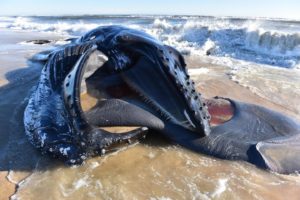
ASSATEAGUE — A rash of dead whales washing up on beaches around the mid-Atlantic region over the last few weeks, including a 33-foot humpback on the Maryland side of Assateague early Monday, had sides pointing fingers at each other this week but there will likely be no answers until necropsies on the deceased marine mammals are completed.
A total of six whales washed up along beaches in New Jersey and New York over a roughly one-month period beginning in early December. In each case but one, no outward sign of traumatic injury was noted. Early Monday morning, Maryland joined the growing list when a 33-foot humpback was discovered on the beach at Assateague on the Maryland side of the oversand vehicle area around mile marker 21.8.
As the whale deaths continued around the region over the last few weeks, including the humpback on Assateague on Monday generated a lot of interest in various local and national news outlets and on social media posts, and subsequently, a lot of finger-pointing. The spike in marine mammal mortality has been linked by more than a few to increased surveying and pre-construction activity off the mid-Atlantic coast by the offshore wind industry.
A total of four offshore wind energy farms are planned off the coast of Maryland and Delaware in lease areas held by two companies. Those projects are in various stages of the approval process and geotechnical ocean bottom surveying including the use of sonar has been utilized at different times.
There has also been speculation the rash of deceased whales has been linked to vessel strikes, but again, just one of the now seven in the last month has shown pre-death outward physical trauma. Of course, a third school of thought is the spike in whale mortality could be just a part of a natural phenomenon made more alarming because if the volume of deceased whales in a concentrated area. In any case, no immediate correlation can be made and won’t likely to be made until the science offers some clarity.
Nonetheless, local governments and environmental advocacy groups are already firing off letters to President Biden’s administration asking for a temporary halt on all offshore wind-related activity until a cause can be determined. On Tuesday, the Worcester County Commissioners voted unanimously to draft a letter to federal officials seeking a temporary halt to offshore wind industry-related activity.
Taking it a step further was Cindy Zipf, executive director of the Clean Ocean Action organization, who pointed the finger directly at offshore wind industry activity in the region for the sudden spike in mortality rates.
“The wave of dead whales is the ocean sounding the alarm,” she said. “We must heed the warning. These tragic multiple deaths of mostly young, endangered whales are of no apparent cause, however, the only new activity in the ocean is the unprecedented concurrent industrial activity by over 11 companies in the region’s ocean, which allows for the harassment and harm to tens of thousands of marine mammals. Moreover, federal and state agencies have been reckless fast-tracking offshore wind development projects.”
Clean Ocean Action fired off a letter to Biden this week calling for the president to take immediate action.
“We write to you to demand an immediate investigation into the marine mammal mortalities from Cape May, New Jersey to Montauk Point, New York or beyond be conducted by qualified scientists including those of the National Marine Fisheries Service, but most importantly overseen by a truly independent team of marine mammal scientists who are experts in marine mammal physiology, biology and behavior,” the letter reads. “Independent international experts should also be consulted. “The investigation must be fully transparent to the public, including investigation status, the activities of the investigation and the reports.”
The Clean Ocean Action letter urges the administration to halt all offshore wind industry activity off the coast until the cause of the mortality spike can be determined.
“We write to you today to demand a halt to all current lessees’ offshore wind energy development activity in the Atlantic Ocean from Cape May, New Jersey to Montauk Point, N.Y., including assessment, characterization, and construction-related activities until an assessment, including required monitoring activities, of the cause of there marine mammal deaths is determined,” the letter to Biden reads. “If offshore wind energy activities are deemed a cause, the moratorium should continue until stringent protection measures are established.”
The offshore wind industry this week was dismissing any connection to the whale mortality and their activities off the coast, including US Wind, one of two companies with offshore wind farm projects in the pipeline off the Maryland coast. Senior Director of Environmental Affairs Laurie Jodziewicz said this week there is no correlation between the whale mortality spike and the company’s activities.
“US Wind feels very strongly that the recent whale strandings are not in any way related to US Wind’s survey activities, given that we have not conducted geophysical surveys, or surveys that map the ocean floor, since May 2022,” she said.
Jodziewicz said the company’s activities off the coast are closely monitored by third-party, independent observers and scientists and pointed her finger back in the direction of the fishing industries.
“When US Wind conducted these surveys in 2021 and early 2022, we, like other offshore wind developers, used third-party Protected Species observers, who are trained and approved by NOAA to detect protected species like whales,” she said. “As NOAA Fisheries has noted, mortality risks to whales are primarily caused by commercial fishing gear entanglements and vessel strikes. There is no evidence that the whale strandings have anything to do with current offshore wind activity off the coast.”
Ørsted also has wind farm projects in the works off the mid-Atlantic coast. Ørsted Deputy Head of Government Affairs and Marketing Strategy Maddy Voytek said offshore wind energy is one of the most scrutinized with layers of review and protections in place.
“Ørsted prioritizes coexistence with our communities and marine wildlife,” she said. “The offshore wind industry is subject to the most stringent level of protections for marine mammals and protected species. Every aspect of our surveys, construction, and operations are reviewed by multiple agencies and subject to protective conditions, including vessel speeds, time of year restrictions for construction activities and mandatory protected species observers.”
Voytek said Ørsted is not currently conducting any survey work in its lease areas, and when it was last spring, it saw no adverse interactions with marine life.
“Ørsted is not conducting survey activity for Skipjack Wind at this time,” she said. “Ørsted-contracted vessels concluded surveys off the Delaware coast in the spring of 2022 and did not experience any marine mammal strikes during their activities. It’s important for all ocean users to continue working with state and federal officials to further advance science-based, smart policies that protect critical wildlife while addressing climate change.”
Marine Mammal Stranding Center Director Sheila Dean said after all of the finger-pointing, the recent spike could be just part of the natural circle of life.
“It just comes in cycles,” she said, noting that the number of whales that have washed ashore in the last few weeks is not out of the norm for high mortality years. “It depends on how many whales are in the area, and I’m going to attribute it to that. There are a lot of whales in our area now.”

